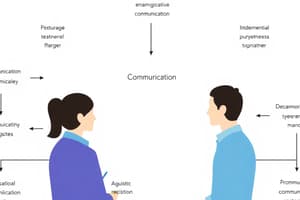Podcast
Questions and Answers
What is a primary benefit of a mission statement for external stakeholders?
What is a primary benefit of a mission statement for external stakeholders?
- It enhances trust and knowledge of an organizations objectives. (correct)
- It reduces the organization's need for external audits.
- It increases internal competition among employees.
- It fosters a sense of unity amongst employees.
A company that is efficient in their operations and as a result offer goods or services at lower prices has which type of competitive advantage?
A company that is efficient in their operations and as a result offer goods or services at lower prices has which type of competitive advantage?
- Market Specialization
- Differentiation
- Niche Focus
- Cost Leadership (correct)
Which mechanism relies on an organization's culture and self-regulation?
Which mechanism relies on an organization's culture and self-regulation?
- Internal control mechanism (correct)
- Supervisory policies
- External control mechanism
- External audits
According to Maslow's hierarchy, which needs are considered most important after physiological needs?
According to Maslow's hierarchy, which needs are considered most important after physiological needs?
Which of these is NOT an example of fulfilling employee safety needs?
Which of these is NOT an example of fulfilling employee safety needs?
What is the primary function of feedback within the communication process?
What is the primary function of feedback within the communication process?
Which of the following best reflects the role of a whistleblower in an organization?
Which of the following best reflects the role of a whistleblower in an organization?
According to Maslow's hierarchy of needs, which level is considered the most basic and foundational?
According to Maslow's hierarchy of needs, which level is considered the most basic and foundational?
What distinguishes an open system from other systems within organizations?
What distinguishes an open system from other systems within organizations?
In the context of management, what is the primary focus of the Blake and Mouton grid?
In the context of management, what is the primary focus of the Blake and Mouton grid?
According to Hersey and Blanchard's situational leadership theory, what determines the appropriate leadership style?
According to Hersey and Blanchard's situational leadership theory, what determines the appropriate leadership style?
Within the levels of management, which level is primarily responsible for strategic decision-making?
Within the levels of management, which level is primarily responsible for strategic decision-making?
What is the main purpose of a mission statement for an organization?
What is the main purpose of a mission statement for an organization?
Flashcards
What is a competitive advantage?
What is a competitive advantage?
A competitive advantage is a unique characteristic that sets a company apart from its rivals. It can be achieved through offering lower prices (cost leadership), providing distinctive products (differentiation), or targeting specific customer groups (niche focus).
What is the purpose of a mission statement?
What is the purpose of a mission statement?
Mission statements are formal declarations of an organization's purpose and goals. For internal stakeholders, it provides direction and unity, while for external stakeholders, it builds trust and clarifies the company's values and goals.
What are safety needs in Maslow's Hierarchy?
What are safety needs in Maslow's Hierarchy?
Safety needs, the second level in Maslow's Hierarchy of Needs, focus on security and stability. This includes feeling safe physically, financially secure, and having access to healthcare.
What are internal and external control mechanisms?
What are internal and external control mechanisms?
Signup and view all the flashcards
What is 'self-actualization' in Maslow's Hierarchy?
What is 'self-actualization' in Maslow's Hierarchy?
Signup and view all the flashcards
Communication Process
Communication Process
Signup and view all the flashcards
Whistleblower
Whistleblower
Signup and view all the flashcards
Maslow's Hierarchy of Needs
Maslow's Hierarchy of Needs
Signup and view all the flashcards
Organization
Organization
Signup and view all the flashcards
Situational Leadership
Situational Leadership
Signup and view all the flashcards
Open System in Organizations
Open System in Organizations
Signup and view all the flashcards
Blake and Mouton Grid
Blake and Mouton Grid
Signup and view all the flashcards
Control Process
Control Process
Signup and view all the flashcards
Study Notes
Communication Process
- The communication process transmits a message from a sender to a receiver through a channel.
- Feedback ensures understanding.
Organization Definition
- An organization is a structured group working together for specific goals.
Whistleblower
- A whistleblower reports unethical or illegal activities within an organization, often at personal risk.
Maslow's Hierarchy of Needs
- A motivational theory prioritizing human needs in a pyramid structure.
- Needs progress from physiological to self-actualization.
Open Systems in Organizations
- Open systems transform external resources into valuable outputs.
- They interact dynamically with their surroundings.
Blake and Mouton Grid
- A managerial tool evaluating leadership styles based on concern for people and production.
Hersey and Blanchard Situational Leadership
- Leaders adapt their style (directive, coaching, supporting, or delegating) based on follower readiness and competence.
Levels of Management
- Top management: strategic decision-making
- Middle management: policy implementation
- Team/Operational: day-to-day supervision
Ethnocentrism
- The belief that one's own culture is superior to others.
Control Process Steps
- Setting performance standards
- Measuring actual performance
- Comparing performance to standards
- Taking corrective action
Quantitative and Qualitative Planning
- Quantitative planning uses measurable data and statistics.
- Qualitative planning considers subjective insights and judgments.
Transactional vs. Transformational Leadership
- Transactional leadership focuses on structured tasks and rewards.
- Transformational leadership inspires change through vision and motivation.
Mission Statements: Purpose and Importance
- Mission statements define an organization's purpose, values, and direction.
- They guide decision-making and align stakeholders.
- They ensure clarity of purpose and motivate employees; communicate goals to external stakeholders.
Impact of Mission Statements on Stakeholders
- Internal stakeholders: foster unity and focus.
- External stakeholders: build trust and understanding of goals & values.
Competitive Advantage Types
- Cost leadership: offering lower prices through operational efficiency.
- Differentiation: providing unique products or services.
- Niche focus: specializing in specific market segments.
Control Mechanisms in Organizations
- Internal control mechanisms are based on self-regulation and organizational culture.
- External control mechanisms involve external supervision, policies, or audits.
Maslow's Hierarchy of Needs - Safety Needs
- Safety needs, second in the hierarchy, include physical security, financial stability, and health.
- Ensuring workplace safety, job security, and healthcare enhances employee well-being.
Maslow's Hierarchy of Needs - Further Details
- Physiological needs are at the bottom of the hierarchy.
- Self-actualization is at the top.
- The hierarchy includes self-esteem, social, and safety needs.
Studying That Suits You
Use AI to generate personalized quizzes and flashcards to suit your learning preferences.
Description
Explore key concepts related to the communication process, organizational structure, and leadership theories. This quiz covers topics like Maslow's Hierarchy of Needs, the Blake and Mouton Grid, and the role of whistleblowers in organizations. Test your understanding of these fundamental theories in an organizational context.




